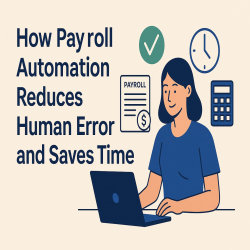
Paystub
How Payroll Automation Reduces Human Error and Saves Time
Payroll is an essential function for every business—but one that's both time-consuming and error-prone when processed manually. With tax laws in a constant state of change and employee structures growing increasingly complex, payroll errors can result in expensive penalties and disgruntled employees.
Enter payroll automation—a contemporary solution that streamlines payroll processing with reduced human errors. In this blog, we will discuss how automated payroll systems operate, how they limit errors, and why they save your team precious time.
What is Payroll Automation?
Payroll automation entails the use of computer software or online applications to process different payroll functions like:
- Determining employee wages
- Withholding taxes
- Generating pay stubs
- Filing taxes with tax authorities
- Processing direct deposits
Rather than manually calculate wages or work with spreadsheets, automation makes the whole process a button click away.
Manual Processing Errors in Payroll
Manual payroll systems tend to result in a variety of errors, including:
- Wrongly calculated wages and hours
- Inaccurate tax deductions
- Procrastination in payments
- Lack of updating employee information
- Incompliance with local regulations
These mistakes not only take time to correct but also put businesses at risk for legal and financial problem.
How Payroll Automation Minimizes Human Error
1. Proper Computations
Computerized payroll system automatically calculate salary, tax, and benefit based on predefined rule. This avoids manual errors and provides consistent accuracy.
2. Instant Updates
Any tax law change, employee information, or company policy can be updated in the system instantly—avoiding old or incorrect data from influencing payroll.
3. Tax Filing on Auto-Pilot
Most payroll software submit local, state, and federal tax on their own. This is done to maintain compliance and prevent missed deadline or inaccurate submission.
4. Validations Built-in
Inconsistencies or missing data are picked up by automated systems so you can fix mistakes prior to processing payroll.
5. Centralized Data Management
One location houses all employee data, timesheets, and pay information. This prevents duplication, data entry errors, or missing documents.
How Payroll Automation Saves Time
Accelerates Payroll Processing
Hours and days are now a thing of the past. Automated processes run multiple employees' payroll simultaneously—saving valuable time with each pay cycle.
Simplifies Tax Reporting
Computer software build year-end tax report (like W-2 or 1099) and summaries automatically, reducing administrative burden from HR or finance personnel.
Less Employee Queries
When employee has access to self-service portal with real-time data, they ask fewer question about pay slip, deduction, or leave balance.
Scales Easily with Your Business
Whether you’re hiring five or fifty new employees, payroll automation grows with you—without adding more manual work.
Final Thoughts
Payroll automation is not merely a convenience—your business deserves a strategic upgrade if accuracy, compliance, and efficient use of time are important to it. Through the elimination of human error and simplification of payroll process, automation allow team to concentrate on expansion rather than paperwork.
If you still do payroll the old-fashioned way, it's time to automate. Long-term gain in terms of time, dollar, and anxiety are worth every penny.